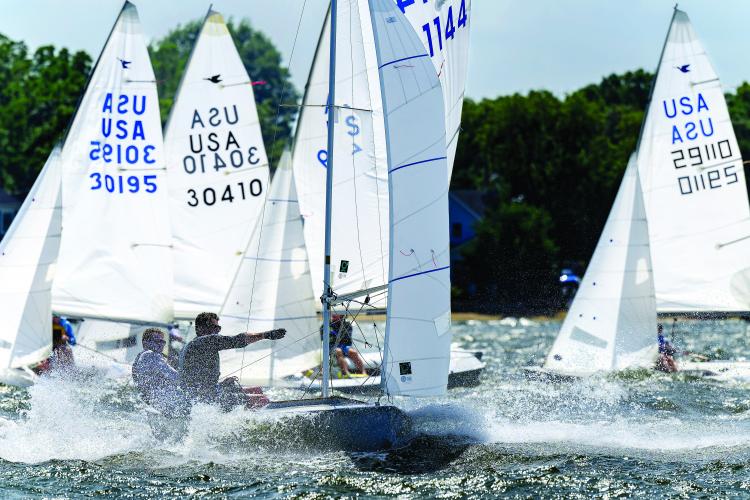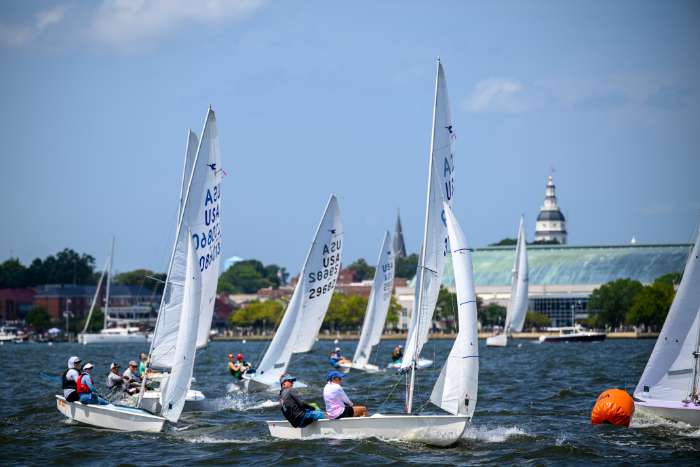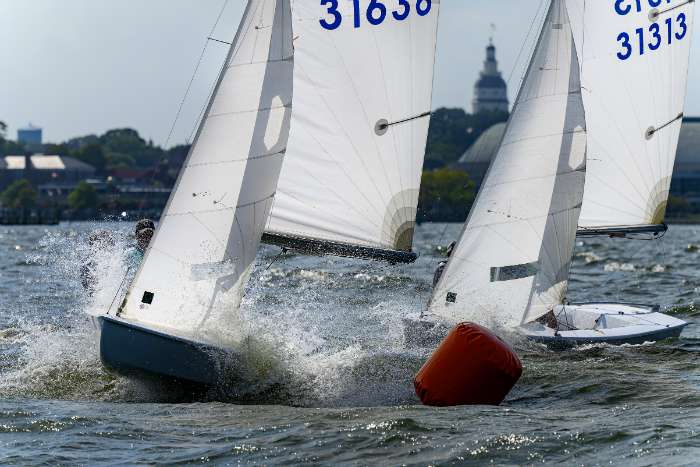The Protest Room: Tips for Racing Sailors
Spending time in the protest room rather than sharing laughs with fellow racing sailors in the boat park isn’t anyone’s idea of a perfect regatta evening. But sometimes it’s necessary.
If you have made the commitment to take a situation to the protest room, it should be because you truly believe you are in the right. You have taken the time to develop and submit your Hearing Request Form, accurately and clearly sharing your perspective (see my first protest tips article). Your hearing time has come, and now you want to present your case effectively. Going into “The Room” can be scary, but these tips can help you navigate the experience.

Be professional.
The protest room is where you discuss your case with the members of the protest committee and the sailors who see the case from a different point of view. Think of it as if you are going to a lawyer’s office for a legal discussion.
- Be on time (which really means be at least five minutes early), and make sure your witnesses are standing by as well.
- You are going into the Protest Committee’s workplace. Yes, you’ve been out sailing all day, but do your best to be at least dry, if not clean!
- Bring supporting materials with you: Copy of the Racing Rules of Sailing, copy of your Hearing Request Form to refer to, and paper and a pencil/pen for taking notes.
- This one should be obvious, but if you are going into the Protest Room, whether as a party or as a witness to the protest, don’t dive into the alcoholic beverages until after you’re done with the process. It is disrespectful and not a good look. First impressions do matter. And of course, it can negatively affect your testimony and participation in the process.

In your opening remarks, walk them through what you see as the “facts found”—the situation as it unfolded. Photo by Ted Morgan
Stick to the facts.
Protest Committees often have multiple points of business to work through on any given regatta evening. Respect their time by keeping your remarks tight and focused.
- In your opening remarks, walk them through what you see as the “facts found”—the situation as it unfolded. Highlight what their conclusion should be (without telling them it should be their conclusion), citing the rule(s) the other team broke. Establish yourself as an expert by accurately describing the context for the situation, including wind speed, direction, and current that affected the incident.
- If the other side in the protest in presenting their remarks offers a description of the incident that is different from yours, don’t roll your eyes, cross your arms, or otherwise visibly or audibly react in a negative way. Your job is to show through evidence, rather than your opinion, that your perspective is the accurate one.
- As the other side describes their view, take notes on your copy of the Hearing Request Form so that you can identify where the perspectives differ. Taking notes on their perspective in a different color pen right next to your views on the diagram can be particularly helpful. For example, you may have described a period of 15 seconds from entering the zone to rounding the mark, while they may say it took five seconds. Jot that down!
- As the discussion continues, think through what questions you can ask that can illuminate those differences. You want to go after the facts they offer in their description—not after them as a person. Perhaps they have not done their homework as completely as you have. When you get the opportunity to ask questions of them, ask questions that will force them to reveal that they are not sure of the facts that they had offered—help them poke holes in their own story. For example, perhaps you can show that it’s impossible for them to have entered the zone and rounded the mark in only five seconds because of how fast your boats go in the wind speed in which you were operating.

Your job is to show through evidence, rather than your opinion, that your perspective is the accurate one. Photo by Ted Morgan
After the decision, no matter what.
You may not agree with the Protest Committee’s decision, but there it is. They have based their decisions on the descriptions of the incident as presented to them by both sides, and the evidence offered to support those descriptions.
- The Protest Committee is made up of volunteers. Sometimes they end up driving in from quite a ways to participate in this process. No matter what you think of the decision, you owe them appreciation for their time and effort. Shake their hands and thank them for the important role they play in our sport.
- Same goes with the sailor(s) on the “other side” in your hearing. 99 percent of the time both sides of a protest situation are going into the room honestly thinking that the way they recall a situation is accurate. Assume good intent from the other side. There are two perspectives. The Protest Committee is simply there to determine what reality is. Thank the other sailor(s) for participating in the process, too.
- The appeal process is there for a reason—if you really think you need it, use it. But do so respecting everyone involved as a fellow participant in our sport of sailing.
Much of what contributes to a positive experience in the protest room boils down to getting the Protest Committee the information they need. What is that information? A great way to learn that is to volunteer to serve on a Protest Committee at your local club. It’s a great experience: You’ll learn about the process, and who knows, you might even enjoy serving on the committee and want to develop your skills in that area!
Find the first part of this two part "protest" series here.
About the Author: Kim Couranz has earned several national and world titles in Laser Radials (ILCA 6), Snipes, and Lightnings. She has also raced J/22s, J/24s, and Ynglings on an international level.




